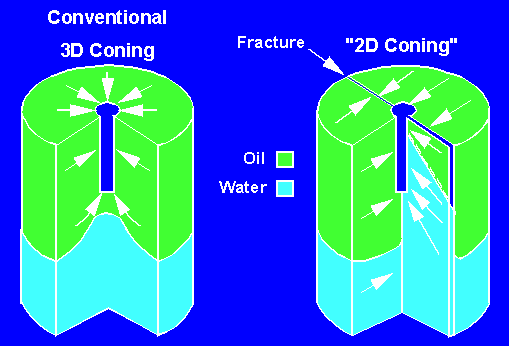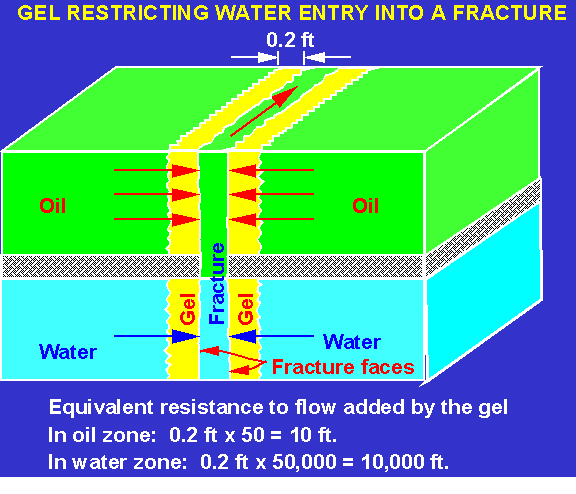2D Coning: Hydraulically Fractured Production Wells
Problem 6 in Table 1

When production wells are hydraulic fractured, the fracture often unintentionally breaks into water zones, causing substantially increased water production. Gelant treatments have significant potential to correct this problem. These gelant treatments rely on the ability of these gels to be placed in the rock matrix adjacent to the fractures and to reduce permeability to water much more than that to hydrocarbon (disproportionate permeability reduction). An engineering-based method was developed for designing and sizing gelant treatments in hydraulically fractured production wells.51 This design procedure was incorporated in user-friendly graphical-user-interface software that can be downloaded from the internet at Dr.Randy's Reservoir Sweep Improvement.

In these matrix rock treatments, gelants flow along the fracture and leak off a short, predictable distance into the matrix rock of all the zones (water, oil, gas). Success for such a treatment requires that the gel reduce permeability to water much more than that to hydrocarbon in the treated matrix rock. The ability of the gel to stop water entry into the fracture is determined by the product of gelant leakoff distance (from the fracture face) and the residual resistance factor (permeability reduction factor) provided by the gel. For example, consider the case where the gelant leaks off 0.2 ft into both water and oil zones, and in the gel-contacted rock, permeabilities to water and oil are reduced by factors 50,000 and 50, respectively. (These properties have been reported for a gel formulation.52) In this case, the gel only adds the equivalent of 10 feet of additional rock that the oil must flow through to enter the fracture (i.e., 0.2 ft x 50). In contrast, for the water zone, the water must flow through the equivalent of 10,000 ft of additional rock to enter the fracture (i.e., 0.2 ft x 50,000). Thus, in this circumstance, the gel can substantially reduce water production without significantly affecting oil productivity.
In this method, fluid entry into the fracture is controlled by gel in rock next to the fracture.51 Ideally, fracture conductivity is not reduced significantly, since it allows a conductive path for oil flow into the wellbore. To some extent, gravity segregation of the gelant (between placement and gelation) will mitigate damage to the fracture when the excessive water production originates from an underlying aquifer. However, to minimize fracture damage, an oil or water post-flush could be used to displace gelant from the fracture.
From a rigorous viewpoint, the method assumes that impermeable barriers (e.g., shale or calcite) separate adjacent zones.51 However, the method should frequently provide acceptable outcomes even if crossflow can occur between the water bearing and oil bearing zones. For example, consider the case where oil lies on top of water in a single formation (i.e., a common situation where coning becomes a problem). Previous work47,52 showed that gravity alone can retard water influx into oil zones much more effectively when the water must “cusp” to a linear pressure sink (i.e., a vertical fracture or a horizontal well) than when the water “cones” to a point pressure sink (i.e., a partially penetrating vertical well). For the type of gel treatment that we are proposing for application in hydraulic fractures, in many cases, gravity may be sufficient to minimize water invasion into the hydrocarbon zones of a single formation. Of course, the degree of water invasion (coning) into hydrocarbon zones increases with increased production rate, pressure drawdown, vertical formation permeability, and hydrocarbon viscosity, and decreases with increased water-hydrocarbon density difference, horizontal formation permeability, and oil column thickness.47,52 If water invades too far into the hydrocarbon zone, a water block could form that reduces hydrocarbon productivity.
To use this procedure to reduce water production from a hydraulic fracture, field data are needed, coupled with results from two simple laboratory experiments.51 The needed field data include:
- fluid production rates before the gel treatment,
- downhole static and flowing pressures before the gel treatment,
- permeabilities, porosities, and thickness of the relevant zones,
- water and oil viscosities at reservoir temperature, and
- well spacing or distance between wells. These parameters are often available during conventional gel treatments.
Use of the procedure also requires oil and water residual resistance factors from laboratory core experiments.51 These experiments must be conducted using the gelant, oil, brine, rock, and temperature that are representative of the intended application. In the absence of laboratory oil and water residual resistance factors, the model can use field data to back-calculate these values in situ after a gel treatment. This information may be useful when designing similar treatments in nearby wells. These calculations have also been incorporated into the software. For cases where residual resistance factors are calculated from field data, three parameters (from a similar, previous gelant treatment) are required in addition to the five items listed in the previous paragraph. These three parameters are:
- fluid production rates after the gel treatment,
- accurate downhole static and flowing pressures after the gel treatment, and
- the volume of gelant injected.
Although somewhat challenging to properly design and execute, strong and/or rigid gel treatments, involving the injection of partially formed gels, can be used to treat 2-D water coning in hydraulically fractured production wells. In this treatment strategy, gravity is exploited to selectively place a partially gelled solution in the lower portion of the fracture.9